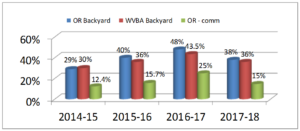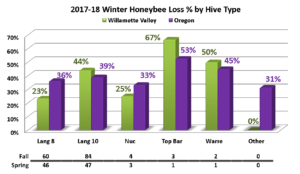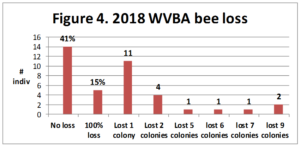With the most recent PNW honey bee survey, the 10th year of such survey activity I received 303 responses from OR backyarders, keeping anywhere from 1 to 50 colonies; Willamette Valley members sent in 34 surveys, 10 more than the previous year, reporting loss/survivorship of 153 fall colonies.
Overwintering losses of WVBA respondents was 55 colonies = 36 %, slightly lower than the statewide loss of 38% (database of 303 OR backyarders.) Percent losses, determined by hive types, are shown below comparing WVBA with the statewide backyarders. WVBA member respondents started winter with 84 Langstroth 10-frame, 60 Langstroth 8-frame hives and 4 5-frame nucs; there were an additional 4 Top Bar hives (2 lost) and 2 Warré hives (1 lost). Losses of 8 framers was less and 10 frame losses were slightly higher compared to statewide beekeepers.
Compared with previous loss levels, the losses in 2016-2017 winter by WVBA backyarders were lower than the previous year but on the average of the previous three seasons. As with last season, WVBA losses were lower than thestatewide loss level (by only 2 percentage points); commercial OR beekeepers typically have ½ the losses of backyarders. 
Typical of the statewide data, the WVBA respondents are largely new beekeepers. 54% of WVBA respondents had 1, 2 or 3 fall colonies, 7 (20%) had 4-6 colonies, 5 had 7 or 8 colonies (14%) and 2 had 10 and another 2 had 12 fall colonies, the largest number for WVBA respondents. Seventeen (50%) had 1, 2 or 3 years of experience, 12 had 4-6 years (35%), one each had 8, 9 or 10 years and 3 had 20+ years experience, the largest was 34 years.
Not everyone had loss. Fourteen WVBA individuals (41%) reported total winter survival; 5 individuals (15%) lost 100% of their colonies. Eleven individuals lost 1 colony, 4 members lost 2 colonies, 1 lost 5, 1 lost 6, one lost 7 and 2 lost 9 colonies, the heaviest loss. Data shown graphically below in Figure 4. Fifty percent indicated acceptable overwinter of 20%. Both 5 individuals chose zero and 50% level as acceptable. Most common responses (6 individuals) was 15% and 20%.
Two individuals had more than one apiary location. Loss at 2nd apiary site was 62.5% compared to 12.5% at home apiary. Four individuals moved bees during the year, one when a commercial moved too close, another to give hive to friend, a third for honey and the 4th within the apiary to have less hive shading.
We asked of individuals that had colony loss to estimate what the likely reason(s) might have been, Multiple responses were permitted. There were 28 selections (1.5/individual). Varroa mites (9) and queen failure (7) were most chosen, with poor wintering conditions and weak in fall (4 individuals each) next. There was 1 individual who checked starvation, 1 checked CCD, another listed wax moth and one said loss was due to a rolled queen.
THANK YOU to all WVBA individuals for filling out a loss survey. Your cooperation is most appreciated.



